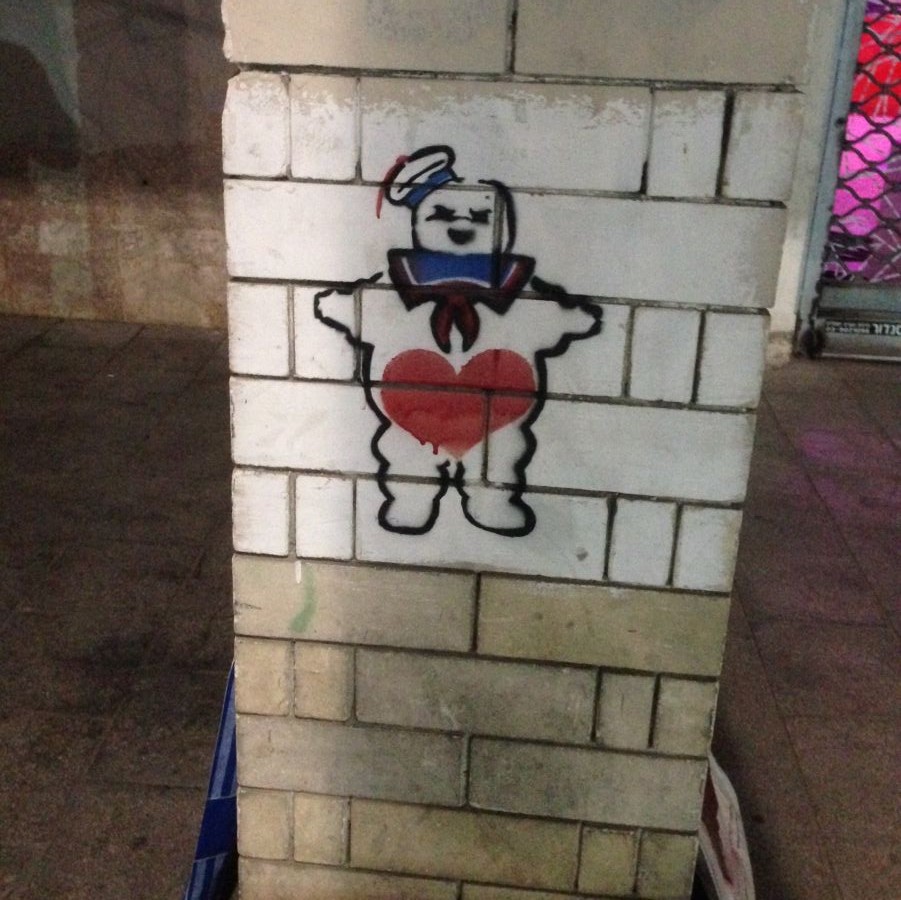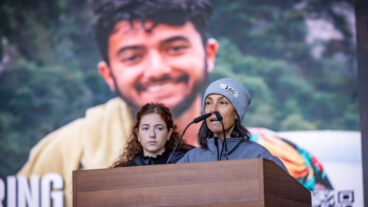When Israeli street artists are exhibiting in galleries here and abroad, when their work stars in videos and walking tours, when makers of clothing and furniture are incorporating their urban designs, you know that graffiti has grown up.
“Seeing the street art in Tel Aviv is a major activity on the list for tourists,” says street artist Mitchell Blickman, founder of the Tel Aviv Street Art & Graffiti website.
“A lot of the people who have been doing in-the-dark street art a long time have actually been becoming more refined, doing exhibitions and commissioned work for bars and clubs, even high-end galleries,” Blickman tells ISRAEL21c, citing examples such as Dioz, Know Hope (Addam Yekutieli), Adi Sened and Mas.

The Tel Aviv neighborhood of Florentin is the epicenter of Israeli street art. You can see it on the walls, in the parks, and in galleries such as Urban Secret Gallery, Tiny Tiny, Under 1000 and Meshuna.
However, it would be a mistake to overlook street-art culture in other Israeli cities, as some of these artists are getting international recognition as well.
Top billing in this category goes to psych-pop collective Broken Fingaz Crew of Haifa.

Broken Fingaz and other established Haifa crews, like 048 and NRC, have inspired a younger generation to go outside and paint. Now in their late 20s and early 30s, Broken Fingaz members Desa, Kip, Tant and Unga spend half the year doing exhibitions and commissions in cities such as Los Angeles, London, Rome, Berlin, Brussels, Dusseldorf, Vienna, Amsterdam, Chengdu, Osaka and Hong Kong.
Speaking to ISRAEL21c from Tokyo, Unga said the crew is “figuring out what we want to say when we’re inside; it’s a different aesthetic or overall approach. Just taking something you did outside and putting it inside doesn’t always work, because street art and graffiti is all about context. Inside, you have to find a way to do something strong enough that can stand alone without the context of the street. So we jump in the water and try new stuff. It’s important to keep things interesting.”

Shutters and shoes
Solomon Souza, 23, has attracted media attention for spray-painting some 200 shop shutters so far in Jerusalem’s Machane Yehuda market (shuk) with portraits of everyone from his grandmother to Bob Marley to famous Israeli Muslims, Christians and Druze.
“We try to pick characters that would inspire anyone,” Souza tells ISRAEL21c.

Souza also sprays in downtown Jerusalem and hipster neighborhood Nachlaot and in the cities of Safed (Tzfat) and Tel Aviv.
Souza says he’d love to collaborate with other Israeli street artists such as One Love of Ashdod and Spine B7 of Beersheva.

French lifestyle brand Bensimon has introduced three new shoe models in collaboration with Israeli street artist and designer Pilpeled(Nir Peled), available in Israel and online.
Pilpeled was the first Israeli artist to design a bottle for Absolut vodka, collaborated on a clothing brand with Puma, drew billboards for a Coca-Cola Zero ad campaign, and did two commissioned murals for WeWork Tel Aviv.

Trends in street art

The styles and motifs of Israel’s street artists are instantly recognizable to those in the know.
If you see a Stay Puft Marshmallow Man or a creatively altered stop sign, it’s a sure bet that Staypuff has been there.
Simian images are the calling card of Wonky Monky.

Stylized Band-Aids on walls in Tel Aviv, London, New York or Berlin indicate Dede, whose new art book can be purchased online and in shops including at the Tel Aviv Museum of Art.

As the better-known street artists mature beyond the walls of Israel, new ones are taking their place.
Shay “Tra” Litman, at only 15, has already been the star of a documentary and several exhibitions.
#Tag, working in Florentin, “is mixing classic art with social media, like an image of the Madonna and child taking a selfie,” says Blickman.

Tiny Tiny owner Murielle Cohen, whose puzzle poems, framed dancers and other series appear in Florentin and environs, says up-and-coming artists are even incorporating technology.

“Street art has changed a lot from tagging, from the pioneers with spray cans,” Cohen tells ISRAEL21c. “It evolved to stencil work and images, and now people are doing out-of-the-box things like digital collages, printed out large and pasted onto walls.”
Beadwork, knitting and other 3D elements are seen in the works of artists such as Mr. Leaf (Mati Ale) and Yifat Raz, who places patches of velvet or fake grass to create petting corners around Tel Aviv.

As the old carpenter shops and seedy apartments of Florentin are gradually being gentrified out of existence, Cohen says developers plan to incorporate street art to keep the area’s flavor and tourist appeal fresh as was done in Brooklyn’s Bushwick neighborhood.
“The world is going in the direction of accepting street art but putting it into a modern context,” says Cohen.

















